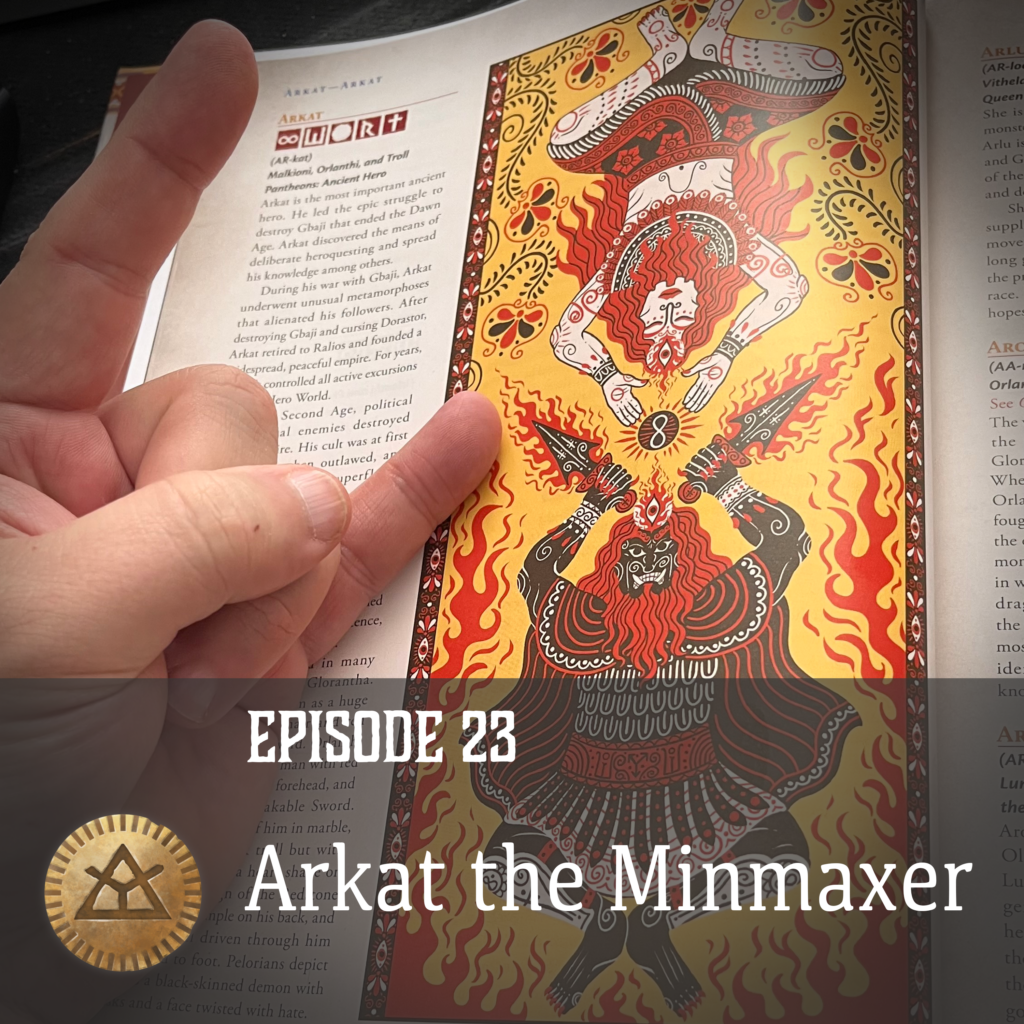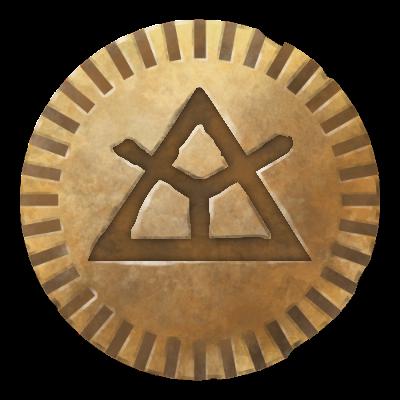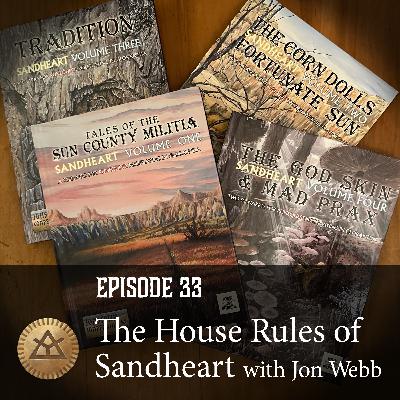Episode 23: Arkat the Minmaxer
Description
 </figure>
</figure>Joerg and Ludo welcome Bud from Bud’s RPG Review, where we see his hands in a typical unboxing set-up, not just doing flip-throughs but also a whole series of explanation videos:
- Bud’s RPG Review YouTube channel
- RuneQuest reviews [1]
- Bud explains… RuneQuest (which, at this time, includes the Lightbringers, the Uz, Illumination, and the Seven Mothers)
[1] It seems that since the episode was recorded, Bud fixed the duplicated RuneQuest video playlist… or maybe Ludo imagined it.
Another place to find Bud is the “Bud and Griff’s Gaming Creepshow” podcast, a “podcast about spooky gaming” (in Bud’s words):
Last but not least, Bud is one of the authors of the Miskatonic Repository bestselling book Viral: A Modern Call of Cthulhu Scenario, with Alex Guillotte. For those of you less involved with Call of Cthulhu, the Miskatonic Repository is the sister community content program to the Jonstown Compendium.
Bud states that his “Bud Explains” videos (which Ludo has faithfully linked from his newsletter) are really for beginners, since delving into the lore of Glorantha can be hard work. He promises more in the future.
Finally you can find Bud on Twitter, if that thing is still going by the time you read this.
Main Topic
Going to our main topic, Ludo says that you will find mention of that guy Arkat in many places, with plenty of lore to dig into. So who is this guy, and why is he cool?
What Does Your RuneQuest Character Knows About Arkat
Bud points out that many of the things Arkat did are kind of hidden.
Arkat is possibly most renowned for being the person who mastered heroquesting and for being the slayer of a god, whom he called Gbaji the Deceiver, but who was known to his worshippers as Nysalor.
Bud remains neutral on whether the deity slain by Arkat was the Deceiver or not.
Ludo gives the context that all of these great deeds happened about 1200 years ago (if you are playing in the normal 1625 time frame). To give a comparison from our world’s history, Ludo suggests a weird Arthurian hero, Jörg interjects that Charlemagne fits the time frame even better. Ludo jokes that Charlemagne was evil because he introduced the school system, but Jörg points out that his evil included the genocide of the Saxons, and that that may be why the peace price of the European Union is named after him.
Getting back on topic, Ludo points out that the Gbaji Wars ended with the blighting and destruction of Dorastor, formerly a beautiful and fertile land.
Bud calls Arkat’s action the rites of cleansing, even though they poisoned the land.
(Arkat did curse the land of Dorastor, and sort of bound the Chaos that had been loosed in the final phase of the Gbaji Wars to this ruined place. The land remained dormant for quite a while until both God Learners and EWF explorers took an interest, which seems to have awakened the land.)
Ludo then talks about Arkat’s star, which appeared when Arkat apotheosized early in the Second Age. Jörg claims that the star vanished since, because the God Learners hid the way.
(Doing some additional research after the podcast, the Guide p.646 claims that Arkat is a prominent constellation in the area of the sky called the Celestial Fields, between the Celestial Forest and the Celestial River.)
(The star map on p. 645 only shows a differently named constellation: the Doves, which is how the Dara Happans name the constellation. They were followers of Nysalor and have no love at all for the slayer of their god, whom they name Gbaji.)
(The list of constellations talks about the constellation of Arkat, stating that only one star was visible there at the Dawn, but that Arkat’s apotheosis caused three bright companions and a number of less bright ones nearby that some claim for the hero as well.)
So Jörg was wrong by remembering correctly that there is no constellation named Arkat on the star map.
Bud then points out that Arkat also is a troll god.
Ludo then sums it up: Arkat was several things to several people, he was some sort of either hero or antihero or evil war general. “He killed a whole bunch of people and did many awesome things.”
The Life of Arkat
Bud starts by telling us that Arkat was born in the elf forests of Brithos, interestingly during the Sunstop… or the Sunspot? Linguistic shenanigans ensue, and come to haunt us.
The Sunstop occurred in the year 375 S.T. (“Solar Time”, after the Dawn) when the Second Council (cooperating with the Dara Happan Empire) created Osentalka, the (presumed) Perfect God, in their capital in Dorastor.
(Several other contributors to the Sunstop include Malkioni sorcerers in Fronela casting a great ritual against the Hsunchen shamans, the Kralori Emperor meditating on a potent symbol – the Dragon’s Eye, and a hundred thousand Aldryami in Pamaltela calling on a good spirit to combat a virulent rot affecting them and their forests. See the Guide to Glorantha p.128 for the wider view. A good introductory read is the history from Cults of Terror, available on the Well of Daliath and reprinted in the Guide.)
Bud goes into detail on Arkat’s birth on Brithos, an island in the western Neliomi Sea that disappeared during the Closing (some say that its disappearance caused the Closing).
Arkat’s birth may have been the creation of the opposite to the newborn god in Dorastor, a balancing force brought in by the universe. The new god was born outside of the Compromise, making the birth of Arkat the opposition of the universe to this insult to Time.
Bud compares this to Argrath being the nemesis of the Red Goddess.
Arkat was fostered by the Aldryami of Brithos, and supposedly illuminated by them at a young age, which Bud thinks is another great irony. About 24 years later he was part of the 4th Brithos Army of Law,
Eventually he became known as the son of Humakt, Arkat Humaktsson.
Progressing through local wars (with the Vampire Kings of Tanisor still as Brithini soldier, then alongside the Seshnegi Men-of-All against the Nieby priests led by Gaalth, then joining the Orlanthi of the upper Tanier River in their fight against Gbaji‘s shock troops, the Telmori who had received Nysalor’s blessing to turn into magical wolves on Wilddays) Arkat became aware of the Riddlers of Nysalor.
In Seshnela, the priests of Nysalor apparently spread poison, or an unhealable disease, and offered healing and protection from it, thereby getting people to worship Nysalor.
Arkat saw and showed that Nysalor had a duality, that he wasn’t just a benevolent god who illuminated people and taught them a different way of thinking, he exposed the deity behind these priests as the Chaos God Gbaji. Arkat made it his life quest to slay Gbaji and free the world from the great Deceiver.
(Much of Arkat’s earliest activities are mentioned in the list of the Kings of Seshnela on the Well of Daliath to greater detail than in the Guide to Glorantha, where p.410 gives details about Arkat’s deeds in Seshnela.)
Skipping far ahead, eventually Arkat managed to invade Dorastor, the homeland of Nysalor, and slew the enemy god atop the Tower of Miracles in the City of Dreams. He supposedly dismembered Nysalor and had its parts scattered and buried around Glorantha.
However, slaying a god doesn’t come easy, and Arkat looked into heroquesting at various points. He brought the Unbreakable Sword with him, the original Death, to enable him to slay a god.
Supposedly when he was on one of his heroquests, he encountered himself as a troll and was wounded by himself, an unhealable wound that he carried with him for his entire life that caused him discomfort.
Also, Arkat is known to have mapped out the Gods’ Realm to enable passage for him, which explains how he ended up so ridiculously powerful.
Before he actually went to slay Nysalor, he underwent the Rite of Rebirth and became one of the Uzuz (the Mistress Troll Race).
There are various pieces of art depicting Arkat as an armoured troll fighting Nysalor.
Once Arkat had killed Nysalor, he created the Autarchy, a.k.a. Stygian Empire, in Ralios and modern Seshnela. Ralios lies west of Dragon Pass, south of Dorastor.
The capital of the Autarchy was A






